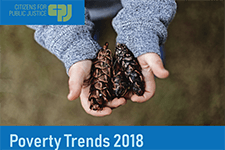Discover financial empowerment resources
Discover financial empowerment resources
This annual report on poverty in Canada reports that a staggering 5.8 million people in Canada (or 16.8%) live in poverty. The report uses several low-income indicators, including the Low-Income Measure (LIM), the Census Family Low Income Measure (CFLIM) and the Market Basket Measure (MBM). Each...

People living in poverty in Canada face multiple barriers. As a country, we can do better to address these persistent challenges. Canada needs a comprehensive national poverty reduction strategy that addresses the complex reality of...
In this report, we look at poverty as measured by income. But poverty is not only felt materially. It can create barriers to social inclusion, positive well-being, and a sustainable livelihood. Municipal, provincial, and federal governments have a key role to play in creating policies that ensure...
This new Poverty Trends Scorecard consisting of four reports now presents an update of the information on income, wealth, and inequality. Over three years later, the recovery has yet to fully take hold. The individuals and families who bore the brunt of the 2008–09 recession face continuing...
